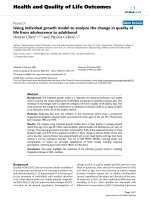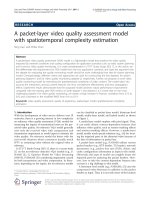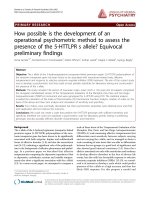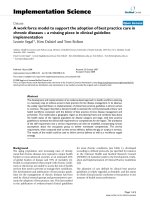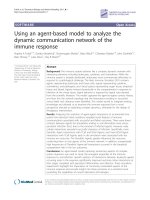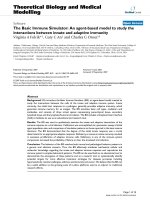Applying house's translation quality assessment model to assess the Vietnamese translation of Mark Twain’s The Adventures of Huckleberry Finn -chapter XX and it105920
Bạn đang xem bản rút gọn của tài liệu. Xem và tải ngay bản đầy đủ của tài liệu tại đây (798.8 KB, 118 trang )
VIETNAM NATIONAL UNIVERSITY, HANOI
UNIVERSITY OF LANGUAGES AND INTERNATIONAL STUDIES
FACULTY OF POST GRADUATE STUDIES
HOÀNG THỊ DIỄM HẰNG
APPLYING HOUSE’S TRANSLATION QUALITY
ASSESSMENT MODEL TO ASSESS THE
VIETNAMESE TRANSLATION OF MARK
TWAIN’S “THE ADVENTURES OF
HUCKLEBERRY FINN”-CHAPTER XX
BY XN OANH
ÁP DỤNG MƠ HÌNH ĐÁNH GIÁ CHẤT LƯỢNG
BẢN DỊCH CỦA HOUSE VÀO VIỆC ĐÁNH GIÁ
BẢN DỊCH TIẾNG VIỆT “NHỮNG CUỘC PHIÊU
LƯU CỦA HUCKLEBERRY FINN”-CHƯƠNG XXDỊCH GIẢ XUÂN OANH
M.A. Thesis
Combined Programme Thesis
English Linguistics
60 22 15
HA NOI-2012
VIETNAM NATIONAL UNIVERSITY, HANOI
UNIVERSITY OF LANGUAGES AND INTERNATIONAL STUDIES
FACULTY OF POST GRADUATE STUDIES
HOÀNG THỊ DIỄM HẰNG
APPLYING HOUSE’S TRANSLATION QUALITY
ASSESSMENT MODEL TO ASSESS THE
VIETNAMESE TRANSLATION OF MARK
TWAIN’S “THE ADVENTURES OF
HUCKLEBERRY FINN”-CHAPTER XX
BY XN OANH
ÁP DỤNG MƠ HÌNH ĐÁNH GIÁ CHẤT LƯỢNG
BẢN DỊCH CỦA HOUSE VÀO VIỆC ĐÁNH GIÁ
BẢN DỊCH TIẾNG VIỆT “NHỮNG CUỘC PHIÊU
LƯU CỦA HUCKLEBERRY FINN”-CHƯƠNG XXDỊCH GIẢ XUÂN OANH
M.A. Thesis
Combined Programme Thesis
Major:
English Linguistics
Code: 60 22 15
Supervisor: Asso. Prof. Dr. Lê Hùng Tiến
HA NOI-2012
iv
TABLE OF CONTENTS
Page
Statement of authorship .................................................................................i
Acknowledgement .........................................................................................ii
Abstract ..........................................................................................................iii
Tables of contents ..........................................................................................iv
List of abbreviations ......................................................................................vii
List of diagrams .............................................................................................viii
INTRODUCTION
1. Rationale ...................................................................................................1
2 Purpose of the study .................................................................................2
3. Research questions ...................................................................................2
4. Research method ......................................................................................2
5. Significance of the study ..........................................................................3
CHAPTER 1. LITERATURE REVIEW
1.1. Translation theory ................................................................................4
1.1.1. Definition of translation .......................................................................4
1.1.2. Translation methods .............................................................................4
1.1.3. Translation equivalence .......................................................................5
1.1.3.1. Three main views on translation equivalence ...................................5
1.1.3.2. Interlingual and intertextual equivalence ..........................................6
1.1.3.3. Typologies of equivalence ................................................................7
1.2. Literary translation ..............................................................................8
1.2.1. Definition .............................................................................................8
1.2.2. Difficulties in literary translation .........................................................9
1.2.2.1. Cultural translation problems............................................................9
1.2.2.2. Stylistic translation problems............................................................11
1.2.2.3. Linguistic translation problems ........................................................12
v
1.2.2.4. Text specific translation problems ....................................................12
1.3. Translation quality assessment ............................................................12
1.3.1. Definition .............................................................................................12
1.3.2. Role of translation quality assessment .................................................12
1.3.3. Approaches to assess the quality of a translation ................................13
1.3.3.1. Models with a quantitative dimension ..............................................13
1.3.3.2. Non- quantitative models ..................................................................14
1.3.3.2.1. Critique productive ........................................................................14
1.3.3.2.2. Functionalist model........................................................................15
1.3.3.2.3. Skopostheorie.................................................................................15
1.3.3.2.4. Descriptive-explanatory model ......................................................16
1.4. House’s model of translation quality assessment ............................... 17
1.4.1. House‘s original model ........................................................................17
1.4.2. House‘s revised model .........................................................................20
CHAPTER 2: RESUTLS AND DISCUSSION
1. Source Text Profile ....................................................................................23
Field ...............................................................................................................23
Tenor ..............................................................................................................26
Mode ..............................................................................................................30
Genre ..............................................................................................................31
Statement of Function ....................................................................................32
2. Comparison of original and translation text and statement of quality
Comparison of original and translation .........................................................32
Statement of quality .......................................................................................40
CONCLUSION ............................................................................................42
REFERENCES
Appendix A. Vietnamese version of the selected text
Appendix B. English version of the selected text
Appendix C. Huck‘s repetition of phrase ―by and by‖
vi
Appendix D. Huck‘s repetition of word ―considerable‖
Appendix E. Huck‘s repetition of word ―considerable‖
Appendix F. Omissions of clausal linkages
Appendix G. Back Translation and Categorization of Overtly Erroneous Errors
vii
LIST OF ABBREVIATIONS
TQA: Translation Quality Assessment
ST: Source Text
TT: Target Text
SL: Source Language
TL: Target Language
viii
LIST OF DIAGRAMS
House‘s Revised Schema for the Analysis of ST and TT
Page 21
Chart of Overtly Erroneous Errors
Page 37
1
INTRODUCTION
1. Rationale
People all over the world are now getting closer and closer thanks to many factors,
among which literature is an important one. Not only can readers entertain but they can also
approach the cultures of a far away country while staying at their home. However, it is a
matter of fact that not everyone is competent enough to read the original text. Therefore, the
readers normally choose to read translation texts. The increasing number of translations
available calls for the need of assessing the quality of such works so that the readers can enjoy
reliable ones.
Given the situation, the evaluation of a translation has become the concern of
Translation Quality Assessment approaches and quite many attempts have been made to find
the answer to the question of how to effectively assess the quality of a translated work. Along
with those attempts are a numbers of related frameworks advocated by some translation
researchers; among which The Translation Quality Assessment Model by the German scholar
Juliane House is one of few approaches considered promising.
This assessment model by House is based on Hallidayan Systemic-Functional Theory,
but it also draws eclectically on Prague School ideas, speech act theory, pragmatics, discourse
analysis and corpus-based distinctions between the spoken and written language. House‘s
Model enables us to analyze and compare an original text and its translation on three different
levels: Language/ Text, Register (Field, Mode and Tenor) and Genre. This study aims to apply
House‘s Model on Mark Twain‘s ―The Adventures of Huckleberry Finn‖-chapter XX and its
Vietnamese translation by Xuân Oanh (2009).
It can be said that this research is a new exciting experience for the researcher in that
she is not a graduate majoring in translation. Therefore, this research first and foremost is to
fullfill the researcher‘s interest in translation and in House‘s Model in particular. In addition,
being able to assess a translation will provide the researcher confidence and knowledge to
practice translation, particularly literature translation.
2
Besides the above reasons, through library reasearch, it is realized that House‘s Model
has been widely applied to assess legal document translation. Therefore, this study seeks to
explore new aspects on utilizing House‘s framework to evaluate a literal translation work.
2. Purpose of the study
In this research, an attempt will be made to apply the Housian TQA Model to identify
two kinds of errors in the translated work: overtly erroenous errors and covertly errornous
errors. The frequency of their occurences will be the foundation to assess the quality of the
target text and to challenge House‘s idea that to literary work, it has to be an overt kind of
translation.
3. Reserch questions
How good is the translation according to House‘s model?
What are the remaining problems of the translation?
Whether the translation is an overt or covert kind of translation?
What might be some implications for the translation of English literature into
Vietnamese?
4. Research method
This study utilizes qualitative design. First, the original text will be read thoroughly
and comprehensively then the source text will be compared to its translation under the
framework of House‘s TQA model. Although, there are quite many models available for
translation quality assessment, House‘s model is applied in that this model provides a
comprehensive set of parameters enable the researcher to assess the translation text on
dimension of both functional and pragmatic equivalence. In addition, as stated by House, the
model can be applied for a wide range of text. The procedure is briefly introduced by Munday
(2001, p.92) as below:
A profile is introduced of the ST register
To this is added a description of the ST genre realized by the register
Together, this allows a ―statement of function‖ to be made for the ST, including
the ideational and interpersonal component of that function (in other words,
3
what information is being conveyed and what the relationship is between
sender and receiver)
The same descriptive process is then carried out for the TT
The TT profile is compared to the ST profile and a statement of ―mismatches‖
or errors is produced, categorized according to genre and to the situational
dimensions of register and genre
A ―statement of quality‖ is then made of the translation
Finally, the translation can be categorized into one of two types: overt
translation or covert translation
As it is impossible for the researcher to analyze the whole text due to limit of time and
knowledge and also to be suitable with the applied framework, only one chapter will be
selected randomly to guarantee the objectiveness of the procedure (chapter XX). However,
examples from other chapters will be taken to prove the generality of the obtained findings in
possible cases.
5. Significance of the study
It is very important to be able to evaluate a translation in that translation has become an
indispensable part in human civilization. In Vietnam, English is a popular foreign language
and is a tool of communication as well as a key to human knowledge. The demand for
knowledge has fostered the development of translation and it seems that many nonprofessionals and semi-professional translators undertake the task of translating. Hopefully,
this study will be a source of reference for other researcher concerning the same issue and
important features of the framework will be ackowledged to have successful translation works.
4
CHAPTER 1. LITERATURE REVIEW
1. 1.Translation theory
1.1.1 Definition of translation
Newmark (1981) defines translation as ―a craft consisting in the attempt to replace a
written message and/or statement in one language by the same language and/or statement in
another language.‖ His definition of translation is then understood as ―rendering the meaning
of a text into another language in the same way that the author intended the text‖. (1988:5)
House (1977:29) defines translation, specifically written translation ―is the replacement
of a text in the source language by a semantically and pragmatically equivalent text in the
target language‖
It can be seen that though definitions on translation are quite diverse, they all seem to
imply that translation does not refer to language as a system but refers to language in use. In
addition, the necessity to reach some kind of equivalence between the two languages is
emphasized in translation.
1.1.2. Translation methods
Newmark (1988:45) introduces a number of translation methods via V diagram as
below:
SL emphasis
TL emphasis
Word-for-word translation
Adaptation
Literal translation
Free translation
Faithful translation
Semantic translation
Idiomatic translation
Communicative translation
This diagram can be briefly explained as follow:
- Word for word translation: The SL word order is maintained and only the most
common meanings of the words are used out of context.
- Literal translation: The SL grammatical constructions are converted to their nearest
TL equivalents but the lexical words are translated singly, out of context
5
- Faithful translation: The SL text is reproduced in its precise contextual meaning
under the constraints of the TL grammatical structures.
- Semantic translation: the aesthetic value of the SL text is greatly emphasized,
compromising on ‗meaning‘ where appropriate so that assonance, word-lay or repetition jars
in the finished version. Consequently, it gains more flexibility and allows the translator to be
intuitively empathetic with the original.
- Adaptation: themes, characters, plots are preserved, and the SL culture is converted to
the TL culture and the text is rewritten.
- Free translation: the translated text or the so-called ―intralingual translation‖ is longer
than the original, often ―prolix‖ and ―pretentious‖
- Idiomatic translation: nuances of meaning tend to be distorted by preferring
colloquialisms and idioms that do not exist in the original
- Communicative translation: the exact contextual meaning of the original is rendered
in such a way that both content and language are readily acceptable and comprehensible to the
readership.
According to Newmark (1988), among the above-mentioned eight methods, only
semantic and communicative translation can fulfill the two main aims of translation namely
accuracy and economy.
1.1.3. Translation equivalence
When analyzing a translation especially literary translation, equivalence is one of the
standards that can not be missed. However, due to its status as a central concept, it is also a
source of controversy. A thorough knowledge of this notion would enable us to understand the
principles underlying models of translation quality assessment presented thereafter.
1.1.3.1. Three main views on translation equivalence
According to Pym (1992:37) ―equivalence is supposed to define translation, and
translation, in turn, defines equivalence‖. In other words, equivalence is a major concept in
translation theory; however, approaches to this concept are considerably different. In this part,
three main views will be introduced.
6
According to Baker and Sandanha (1992) in the Routledge Encyclopedia of
Translation Studies, authors such as Cartford, Nida, Taber, Toury and Koller consider
equivalence an essential requirement in translation and it can be achieved. However, authors
Snell-Hornby and Genzler reject the theoretical notion of equivalence. They claim that it is
either irrelevant or causes damage to translation studies. Yet other theorists have a neutral
viewpoint on this concept. Baker uses the notion of equivalence ―for the sake of conveniencebecause most translators are used to it rather than because it has any theoretical status‖ (p: 56).
It can be said that those contradictory views on translation equivalence results from
different views on the nature of translation. Authors in the first group consider translation as a
communicative process, the focus of which is to convey the message from source text into
target text. The second group see translation as a brand of linguistics absolutely, thus,
translation equivalence is mechanically the transference of meaning units from source text into
target text. The third group although sees absolute translation equivalence is irrelevant, thinks
that equivalence is still achieved and translation is a means of communication for people of
different languages. This is quite a thorough view on translation equivalence in that both
communicative aspect and linguistic aspect are taken into consideration when translation is
discussed.
1.1.3.2. Interlingual and intertextual equivalence
It is a shortcoming to put equivalence in discussion without mentioning two terms
interlingual and intertextual equivalence. From the early time when equivalence is discussed,
theorists distinguish ―elements of abstract language systems‖ from ―elements of real source
texts and target texts‖ which are referred to as formal correspondence and textual equivalence
respectively. Koller (1979: 183-4), in his similar attempt, introduces two terms:
―Korrespondenz‖, formal similarity between language systems, and ―Aquivalenz‖,
equivalence relations between real texts and utterance. According to Koller it is ―Aquivalenz‖
that translation studies have to focus on.
Similarly, Toury (1980:24-6) charts the evolution of the notion of TRANSLATION
ABILITY from an interlingual phenomenon to an intertextual one. Hence, the concept of
7
equivalence was soon popularly understood as a relationship between texts in two different
languages, rather than between the languages themselves. According to Kenny (2001,99) this
step enabled us to reject the translation-ability on the basis of entire language systems with
―all their unactualized meaning potential‖. Kenny also adds that the shift from differences in
language structures between languages to texts and utterances makes translation ―not only
more tractable, but also more realistic‖ thanks to reference to co-text and context.
Narrowing down the broad concept of equivalence into textual equivalence has made it
easy for us to approach a translation text. The next part will briefly present some prominent
equivalence typologies.
1.1.3.3. Typologies of equivalence
Different views on translation equivalence leads to a varieties of typologies of
equivalence.
Koller (1992) categorizes equivalence into five categories: denotative equivalence (ST
and TT refer to the same thing in the real world), connotative (the ST and TT words trigger the
same or similar associations in the minds of native speakers of the two languages) , textnormative (ST and TT words are used in the same or similar contexts in their respective
languages) and pragmatic or dynamic equivalence introduced by Nida (1964) (ST and TT
have the same effect on their respective readers) and formal equivalence (similar orthographic
or phonological) respectively.
Baker (1992) extends the concept of equivalence to cover similarity in source text and
target text information flow and in the cohesive roles that source text and target text devices
play in their respective texts. She calls these two factors combined textual equivalence.
Newmark (1994) stresses that not all the variables in translation are relevant in every
situation and that translator must decide which considerations should be given priority at any
one time, thus establishing a kind of functional equivalence.
Kade (1968) and other writers on lexical equivalence , in particular in the area of
terminology combine the above qualitative distinctions with a quantitative scheme that
categorizes equivalence relationships according to whether there is: a single expression in the
target language for a single source language expression, i.e. one-to-one equivalence; more
8
than one target language expression for a single source language expression, i.e. one-to-many
equivalence; a target language expression that covers part of a concept designated by a single
expression, i.e. one-to-part-of-one equivalence; or no target language expression for an source
language expression, i.e. nil equivalence. This quantitative, lexical approach reflects an earlier
concern with language systems and has been criticized precisely because it is restricted to the
word level and because it assumes that the language system can be equated with concrete
realization in text (Snell-Hornby, 1988:20)
1.2. Literary translation
The above part has discussed some major terms in translation theory, which form the
foundation for any kind of research on translation. The next part will present literary
translation in general and challenges in literary translation.
1.2.1. Definition
Bush (1998) defines literary translation as follow:
―Literary translation is the work of literary translators. That is a truism which has to serve as a starting
point for a description of literary translation, an original subjective activity at the center of a complex
network of social and cultural practices. The imaginative, intellectual and intuitive writing of the
translator must not be lost to the disembodied abtraction which is often described as ‗translation‘‖
(p:127)
Talking about the work of a literary translator, Lamberts (1998:130) considers ―a
published translation is the fruit of a substantial creative effort by the translator, who is the key
agent in the subjective activity and social practice of translation.‖ He claims it is the literary
translator who decides how to translate and gives the literary translation its existence no matter
what restraints of the network of social and cultural factors are. To emphasize the challenges
of literary translation, Landers (2009:9) adds that ―literary translation entails an unending
skein of choices.‖
While, the above mentioned authors view literary translation more as a subjective and
creative activity of the translator, Toury (1993: 12-13) cited in Sanchez, emphasizes aspect of
equivalence between source text and target text in literary translation and defines it as two
different concepts:
9
i) the translation of texts which are regarded as „literary‟ in the source culture. The
focus of this kind of translation is to construct the so-called ―web of relationships‖ of the
source text, the one which makes that text a unique instance of performance.
ii) the translation of a text (in principle, at least, any text) in a way that the product be
acceptable as “literary” to the recipient culture.
In the first sense, the text is considered to be a literary piece of work in the source
culture and its rewriting is considered as such. In another sense, the focus is on the receiving
end or the nature of the text in accordance with tastes, traditions, what is regarded as literary in
target culture independent of the source culture. In other words, source text and target text
belong to two different genres. However, it is not very often that what is normally classified as
a literary text in one language is not recognized as such in another language
It can be seen that definitions of literary translation vary depending on the authors‘
emphasis. While writers such as Bush, Lampert and Newmark emphasize the subjective work
of the translator, others focus on the degree of equivalence between the ST and TT. No matter
how different they are in their view of literary translation, no one can deny that literary is
challenging. The next part will discover prominent difficulties that translators have to cope
with literary translation as ―when there is any kind of translation problem, literal translation is
normally (not always) out of the question‖ (Newmark, 1988:70)
1.2.2. Difficulties in literary translation
1.2.2.1.Cultural translation problems
It can be said that culture is an important key role that enables one to understand a
literary work, which is quite a relatively difficult issue to tackle even in the source language,
not that of target text. It is crucial for a translator to understand beliefs, attitudes, values, and
rules of the source language audience so that he or she can successfully translate it for people
of different sets of beliefs, attitudes, values, and rules. The closer the two cultures are, the less
challenging the work of the translator. For example, Larson (1984:95) points out that some
societies are more technical and others less technical; therefore, it will be really a hard job for
the translator to work with a text originating from a highly technical society to a non-technical
10
society target readers. For those reasons, failure to understand the source language‘s cultures
will definitely affect the quality of the translation.
Though no translator can think low of cultural differences when translating, how to
overcome such challenges is not a question easy to answer, Larson (1984) says that:
―The receptor audience will decode the translation in terms of his own culture and experience,
not in terms of the culture and experience of the author and audience of the original document.
The translator then must help the receptor audience understand the content and intent of the
source document by translating with both cultures in mind.‖ (p.436)
Dealing with cultural specific problems in literary translation, Nida and Taber
(1969/1982) have their own definition and approach. They define cultural translation as "a
translation in which the content of the message is changed to conform to the receptor culture
in some way, and/or in which information is introduced which is not linguistically implicit in
the original" (p:199). In the context of Bible translation, they state that a cultural translation is
one in which additions are made which cannot be directly derived from the original ST
wording. Thus, these additions might take the form of ideas culturally foreign to ST or
elements which are simply included to provide necessary background information.
(Shuttleworth & Cowie, 1997: 35).
Different authors use different terms to refer to words in source language that are
totally unknown in the target culture. While Gambier introduces the concept ―cultural-specific
references‖, and for Baker (1992) it is ―cultural-specific items‖ or ―cultureme‖ by Nord
(1997), Newmark (1988:96) uses ―cultural word‖ and suggests that the translations strategies
applied in such cases are dependent on elements such as text-type, requirements of the
readership and client and the importance of the ―cultural word‖ in the text. According to him,
most ―cultural words‖, are not difficult to be realized in that they have associations with a
particular language and cannot be literally translated.
Newmark (1988) advocates the utilization of two translation procedures which are of
two opposite perspectives. At one end, it is transference popular in literary texts characterized
by local color and atmosphere in specialist texts that make it possible for readers to identify
11
the referent in other texts without difficulty. However, brief and concise as it is, transference
may block comprehension for its emphasis on the culture and exclusion of the intended
message.
At the other end, it is componential analysis, the most accurate translation
procedure, which excludes the culture and highlights the message. In componential analysis,
one can add extra contextual distinguishing components in addition to a component common
to the source language and the target language. Unavoidably, a componential analysis is not as
economical and does not have the pragmatic impact of the original.
In addition, Newmark (1988) points out that many cultural customs are described in
ordinary language, where literal translation would distort the meaning and thus the translation
―may include an appropriate descriptive-functional equivalent‖ (p:95). Besides the abovementioned procedures, the author also reminds the necessity to take the motivation and the
cultural specialist and linguistic level of readership into consideration when dealing with
cultural words.
1.2.2.2. Stylistic translation problems
Style is also a problem challenging literary translation. Style can be understood as the
way one says a things or the way something is written as distinct from its subject matter. In a
natural way, each language has its own problem of style, however, the decisions that literary
translators have to make seem to be similar when tackling with this kind of problem.
For a technical text, for example, style is not a problem in that its informational content
remains from ST to TT. Landers (2001, p:7) use the metaphor freight-train to illustrate the
importance of taking style into consideration in literary translation. ―In technical translation
the order of the cars is inconsequential if all the cargo arrives intact. In literary translation,
however, the order of the cars- which is to say the style- can make the difference between a
lively, highly readable translation and a stilted, rigid, and artificial rendering that strips the
original of its artistic and aesthetic essence, even its very soul‖
There are so many things to discuss concerning style. According to Landers, in theory
at least, ―style‘ in a translator is an ―oxymoron‖. In order to perform his or her task well, it
would be best if the translator strives to have no style at all and disappears into and become
12
indistinguishable from the style of the SL author. Preferably, the translator should adapt to the
style of each author translated but always as faithful to the original as circumstances permit.
1.2.2.3. Linguistic translation problems
Linguistic translation problems arise due to structural differences between the source
language and the target language. Linguistically, each language has its own metaphysics,
which determines the spirit of a nation and its behavioral norms, and this is what is known as
linguistic relativity or the Whorfian hypothesis. It rejects the commonly held belief that all
people of different countries have a common logical structure when processing with language
independent of communication. Instead, it emphasizes the influence of linguistic patterns on
the way people perceive the world. Consequently, the modes of thinking and perceiving in
groups utilizing different linguistic systems will result in basically different world views.
Since words or images may vary considerably from one group to another, the translator needs
to pay attention to the style, language and vocabulary peculiar to the two languages in question
in order to produce an 'exact' translation of the source language text.
1.2.2.4. Text specific translation problems
These elements prove to be bound to this specific source text. In order to be able to
understand and translate them, one must know what they are and what they refer to, and this is
only possibly when the entire novel has been read.
1.3. Translation quality assessment
1.3.1. Definition
Among a variety of definition on TQA, the one presented by Lawson (2011) would be
the most comprehensive one. Translation criticism, in Lawson approach, does not stop at
―stating the appropriateness of a translation, which naturally also implies a value judgment,
though it need not be quantified or even made explicit‖ (McAlester 1999:169). Lawson
(2011:6) says that translation quality assessment ―attempts to set out the interpretative
potential of a translation seen in the light of an established interpretative framework whose
origin lies in the source text‖
1.3.2. Role of translation quality assessment
13
Newmark (1995) regards translation criticism or
TQA as a crucial link between
translation theory and its practice and as ‗the keystone of any course in comparative literature,
or literature in translation, and a component of any professional translation course with the
appropriate text-types as an exercise for criticism and discussion.‘ He clearly states the
important role of TQA for three main reasons.
In the first place, by criticizing others‘ translations translators could perfect their
competences as well as gain essential professional experiences. Besides, TQA could help
translators expand their knowledge and understanding of linguistics regarding their mother
tongues and the foreign language, as well as topics discussed in the translation. Last but not
least, this activity is a good chance for translators to, first, re-organize their knowledge of
translation regarding translation principles and then, to sharpen their comprehension of
translation theories which are inevitably crucial for professional translators.
1.3.3. Approaches to assess the quality of a translation
Williams (2004) present a thorough study of available TQA models which are categorized into
quantitative and non-quantitative approaches.
1.3.3.1. Models with a quantitative dimension
Canadian Language Quality Measurement System (Sical): Developed by the Canadian
government‘s Translation Bureau, the best known one, at least on the Canadian scene.
Systeme devaluation positive des traduction (SEPT): Developed for the Translation
Bureau by Daniel Gouadec but never put into practice of its complexity.
J2450 Translation Quality Metric: Developed in 2000 by the U.S Engineering Society
for Advanced Mobility in Land, Sea, Air and Space to give a ‗standardized grade‘ to
translations for technical maintenance and repair institutions.
Discourse analysis model
On the basis of works by Searle (1969), Halliday and Hasan (1976), Widdowson
(1978), and van Dijk (1980), Bensoussan and Rosenhouse (1990) suggest a TQA model
for evaluating student translations by discourse analysis which differentiates errors
